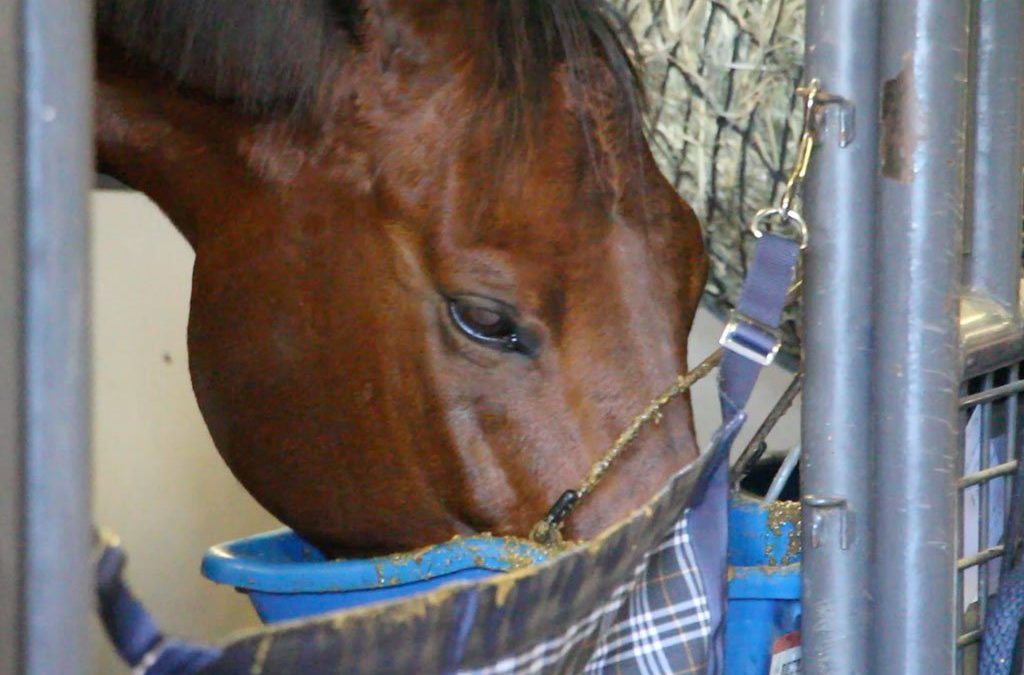To digest and absorb
Feed additives appear to help maintain proper function of the delicate digestive tract
A horse primarily obtains feed while grazing and browsing. When offered pasture as its primary source of nutrition, a horse depends largely on hindgut fermentation, using a variety of hydrolyzable (susceptible to enzymatic digestion) and fermentable carbohydrates as its main energy source.
The equine stomach contains regions capable of both enzymatic and limited fermentive digestion, while the small intestine performs predominantly enzymatic digestion of starches, proteins, fats, vitamins, and some minerals. Enzymes are secreted from the stomach, small intestinal lining, and pancreas for digestion in the stomach and small intestine. The cecum and colon, collectively called the hindgut, are where digestion of fiber occurs. Fiber is digested through enzymes secreted by the microbial populations that reside there. Microbial enzymes break down the fiber into products called volatile fatty acids, which the horse uses to produce energy and other metabolic functions.
Rarely are digestive or metabolic disorders such as colic, laminitis, gastric ulcers, and tying up seen in horses that exist under natural grazing conditions. Racehorses, however, have limited opportunity to meet their nutrient requirements through grazing pasture and obtain about 50% of their diet through harvested grasses and legume forages; the other 50% comes from concentrated feeds rich in hydrolyzable starches and sugars.
Diets of this composition are much more difficult for the horse to digest, particularly when it consumes large amounts, and various digestive and metabolic disorders can be attributed to such a diet. Improvements in feed processing include steam-flaking grains, extrusion, and pelleting to help with digestibility. Feed manufacturers have begun to use feed additives such as enzymes, direct-fed microbials (probiotics), yeast cultures, and highly absorbable chelated minerals that appear to increase digestibility and absorption of nutrients and help maintain proper function of the horse’s delicate digestive tract
Enzymes
The scientific community has recognized the importance of incorporating enzymes into animal feeds. Research has helped to explain the properties of enzymes and how they function.
Commercial enzyme products are fermentation extracts of bacterial or fungal origin. Enzymes are proteins that catalyze or facilitate chemical reactions during biological processes such as digestion of feed, energy production, and all metabolic functions. Because enzymes are highly specific for fats, proteins, or carbohydrates, digestion of a particular feed stuff requires the activity of many different enzymes.
Enzyme research is in the fore-front in the dairy, poultry, and swine industries, but little has been conducted with equines. Research results have been conflicting, but some studies with birds, cattle, and pigs have shown improvement in feed digestibility. Factors that can affect results include diet composition, type of enzyme preparation used, enzyme stability, level of enzyme included, and method of application.
One promising study conducted with horses showed that the enzyme amylase applies directly to grain increased starch digestibility. Because the equine digestive tract was not designed to process large quantities of starchy feeds, the low amount of amylase produced by the horse could be a limiting factor in complete starch digestion in the small intestine. Adding amylase to equine rations may reduce the amount of starch that passes through to the hindgut, reducing the risk of acidosis. Acidosis might occur when starch is fermented in the hindgut, and result in increased acid production and lowered pH.
Few feed companies offer enzymes already incorporated into their feed products for horses, mainly due to lack of research about the efficacy of these additives. Enzymes are proteins that are easily denatured or structurally altered and rendered inactive when exposed to temperature and pH fluctuations. The ability of an enzyme to remain intact and functional after being subjected to the high temperature and acid environment of the equine stomach is questionable.
Also, enzymes incorporated into feeds must be able to withstand the processing of the feed. For example, the steam used to manufacture pelleted feeds causes considerable loss of enzyme activity if it is too hot, but data from the poultry industry has shown that enzymatic activity was preserved at normal pelleting temperatures of 75 ⁰ to 80 ⁰.
Another option for adding enzymes to feed is spraying liquid enzymes on the final feed product after conditioning and processing. Further investigation on the usefulness of adding enzymes to equine rations is certainly needed to determine if digestibility of nutrients, particularly starch, can be improved and enhance the digestive health of the horse.
Direct-fed microbials
Direct-fed microbials, also called probiotics, which means “for life”, have been used in equine feeding programs for many years. They contain two lactic acid-producing bacterial species that are considered to be beneficial bacteria in the hindgut.
The original premise behind feeding direct-fed microbials was to prevent the establishment of pathogenic microorganisms and reestablish the normal gut microflora. Bacteria that cause disease in the hindgut can reduce the ability of the horse to absorb nutrients. Lactic acid-producing bacteria can attach to the muscosal lining and produce a substance that prevents harmful bacteria from binding to the intestinal wall. Additionally, when beneficial bacteria attach to the intestinal wall, they actually may increase the absorptive surface area and enhance the activity of enzymes, which increases nutrient absorption by the horse.
Organisms that produce lactic acid help to maintain a slightly acidic environment in the hindgut that is not hospital to pathogens. They also secrete small amounts of hydrogen peroxide, which make the environment non-conducive to supporting bacteria that require oxygen for their metabolism (all the good bacteria in the hindgut are anaerobes, meaning they do not require oxygen to exist). Lactic acid-producing bacteria also are capable of suppressing the growth of pathogens that cause diarrhea.
Direct-fed microbials routinely are used whenever a horse has been under a good deal of stress from training or shipping, has had a digestive upset, or has been on a course of antibiotics, which kill good and bad bacteria. Direct-fed microbials are helpful in establishing new bacterial populations, particularly in young foals that are born with a completely sterile hindgut. Adding direct-fed microbials to equine rations also has been purported to increase milk production in lactating mares, improve growth rates in foals, boost the immune system, and reduce incidence of sporadic colics.
Direct-fed microbials may help to improve digestibility of feeds and minerals such as calcium and zinc. Because hindgut bacteria also are responsible for digestion of much of a horse’s diet, establishing and maintaining a healthy hindgut bacterial population are essential.
Yeast culture
Another feed ingredient routinely added to equine rations is yeast culture (Saccharomyces cerevisiae). Yeast culture is used to stabilize the hindgut bacterial populations and increase nutrient digestibility. It synthesizes many proteins and secretes all essential amino acids.
Many studies have been conducted with horses as to the usefulness of this ingredient. Adding yeast culture to the diets of horses has been shown to enhance the activity of fiber-digesting bacteria in the hindgut, which results in increased fiber digestibility and more efficient use of the vitamins and minerals derived from the forage portion of the diet. This important in the growing horse because calcium and phosphorus are essential dietary minerals for proper bone development.
Some of the phosphorus found in forages is bound to the plant fiber in the form of phytin phosphorus and is not readily digested and absorbed. Research studies have shown 20% increase in phosphorus availability when yeast culture is added to the diet. Yeast culture stimulates the hindgut bacteria to produce the enzyme phytase, which acts to break down the bond between the fiber and the phytin phosphorus, making it readily absorable from the hindgut.
Lactating mares fed yeast culture have higher concentrations of sugars, fats, proteins, and amino acids, and their foals were shown to have higher average daily gains due to increased availability of nutrients. Older horses will benefit directly from the addition of yeast culture due to increased fiber digestion and phosphorus absorption from the large intestine, which commonly deteriorates and loses some absorptive capacity due to aging.
In one research study, horses in training benefited greatly when fed a diet with added yeast culture, with lower blood lactate levels before and during exercise and faster clearance of lactate from the blood following exercise than did the control horses not receiving yeast culture.
Chelated minerals
New technology using chelated minerals has greatly enhanced absorption of this class of nutrients. Chelation involves bonding the mineral to nitrogen (usually supplied by amino acids), and chelates are organic molecules that contain a ring structure that protects the mineral from degradation.
This is important because minerals in the inorganic form, such as those found in trace mineral blocks, are large, and their molecular structure must be broken apart and restructured before being absorbed. They then can combine with other substances, making them less available to the horse. Chelated minerals have a neutral electrical charge and, therefore, are absorbed more efficiently through the intestinal wall.
Forages and grains supply minerals, but their mineral content and availability can be highly variable due to growing conditions, soil pH, plant species, stage of maturity at harvest, and soil mineral concentrations. For example, certain parts of the United States, particularly the Northwest and Northeast, are deficient in soil concentrations of selenium, and higher inclusion rates must be added to the diet.
Horses require minerals in certain amounts and also in ratios with regard to each other. For example, calcium and phosphorus must always be supplemented in a ratio where the amount of calcium fed is 1 1/2 to two times the amount of phosphorus fed. If the ratio is inverted, several metabolic conditions can occur, including abnormal bone growth. If excess levels of calcium are fed, zinc absorption can be affected; high levels of iron can impair manganese and copper absorption.
Mannan oligosaccharide
Mannan oligosaccharide is a carbohydrate derived from the cell wall of yeast. In recent years, large-scale studies with a variety of species have shown the ability of the carbohydrate to block the colonization of intestinal pathogens and increase immune response. Pathogenic bacteria are attracted to mannan oligosaccharide and readily bind with the carbohydrate rather than attaching to the intestinal mucosa. Once bound to mannan oligosaccharide, pathogenic bacteria are excreted with the feces.
Many studies with poultry suggest that mannan oligosaccharide can be used to replace growth-promoting antibiotics in the diets of growing birds. Studies with calves showed a significant reduction in respiratory problems, possible a direct result of immune stimulation and increased production of macrophage activity.
One study from the University of Florida involving mares and foals supplemented with mannan oligosaccharide showed that pregnant mares supplemented with ten grams of the carbohydrate daily from 56 days pre-foaling to 56 days post-foaling produced colostrum with higher levels of immunoglobulins IgG, IgM, and IgA. Higher IgG transfer to the foal via colostrum helps to ensure resistance to pathogens that produce various diseases.
Another study conducted by the University of Florida examined the effects of feeding mares mannan oligosaccharide and its effects on immunoglobulin content of colostrum, body condition of the mares, and foal weights. Results showed increased immunoglobulins in colostrum, and the foals receiving this colostrum tended to have less incidence of diarrhea. One interesting observance was that foals out of supplemented mares were born with lower birth weights than those from non-supplemented mares, and those foals did not catch up by the end of the experiment.
Mannan oligosaccharide may be useful in equine rations by helping young foals receive high levels of antibodies through passive transfer and to help colonize their intestinal tracts with healthy organisms. Horses in training could benefit from increased immune response associated with supplementation of the carbohydrate. Horses affected by exercise-induced pulmonary hemorrhage (bleeders), chronic obstructive pulmonary disease (heaves), and chronic intestinal disturbances also may be candidates for supplementation.
Continued research is needed to determine which feed additives can contribute to the health and well-being of all horses, but it is particularly important for horses in intensive exercise programs that endure much physical and mental stress.
By Dr. Amy Gill, originally published in the Thoroughbred Times


